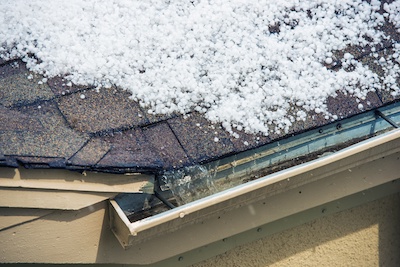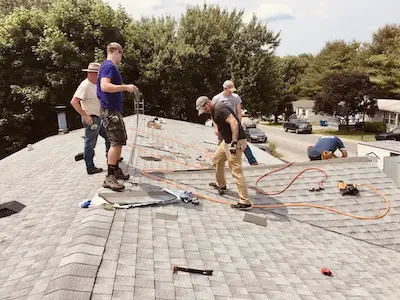What Is The Purpose of a Drip Edge for Your Roof?
I was looking to make some updates to my home, including my roof, and wondered if drip edge was necessary if I got my roof replaced. I took a look at what the experts had to say.
So, does your roof need some drip edge? One of the most overlooked pieces of a new roofing system is the drip edge at both the rake and the eaves. If your area experiences intense storms, you definitely need a drip edge for your roof. If your roof doesn’t have a drip edge installed, professionals recommend adding it to your roof whenever it is serviced or replaced.
Keep reading to learn more about how this addition to your home can add value and protect both your home and the roof itself!
What Is Drip Edge?
Drip edges are metal sheets, usually shaped like an “L,” installed at the edge of the roof. Also called drip edge flashing or D-metal, they serve a vital function by directing water away from the fascia and into the gutter.
Fascia, roof fascia, or fascia boards are horizontal boards that run under the roof edge. Fascia hangs over the wall of the building and provides protection to the rafter and interior structure of the roof. Drip edge overhangs the sides of the roof and has a small metal flange that is bent away from the fascia. It is non-corrosive and non-staining so that your roof looks good but is structurally stable.
Without a drip edge, water may end up beneath the shingles and may cause damage to various parts of the home. Though your home may not have originally had a drip edge installed, drip edges are now required by most building codes across North America to protect homes from damage.
The edges of a roof receive the most moisture, particularly those of irregular or steep-sloped homes that require the most protection. Any shingles that extend beyond a certain point are going to eventually bend and fracture along the edges.
This means that without a drip edge, water can get under the shingles and cause staining and deterioration of the lower roof deck area and the band under the roof edge (fascia board). If the condition exists for any length of time, the roof joists or trusses that connect the fascia board can also be affected.
Contractors often tell homeowners that drip edge can be a waste of money. However, if you have rotting fascia or decking at the eaves and rakes, then your roofing system is broken and there is a simple solution that can solve your problems. A roofing expert from a local business would argue that drip edge is an extremely important part of home maintenance. I tend to go with the experts.
When Should I Get a Drip Edge?
A roof installation that follows manufacturing standards and recommendations will specify that a drip edge is included. Whether installing a new roof on a home or undergoing new construction of a home, the inclusion of a drip edge should be part of any quality roof installation package
. If a new roof is going to maintain soundness, and value is going to be added to a home, a drip edge is a necessity. Without it, the integrity of a roof is compromised and damaging effects to shingles and other parts of a roof will be observed in the years that follow, which will eventually lower the value of a home.

Reasons to Use Drip Edge
Drip edge directs water away from the fascia and prevents water from rotting the fascia over time. Due to cohesion, surface tension, and other forces, water droplets tend to stick to one another and to the surfaces they are on, albeit slightly.
A drip edge is designed to take advantage of those forces and, along with gravity, direct water into the gutter.
If the home has no gutter, the drip edge will prevent the water from running down the fascia and onto or into the soffit cavity. However, without the drip edge, the water sticks to shingles, potentially working its way under the shingles to cause a leak.
For example, water may cling to the fascia, which may cause rot, or, in severe conditions, a leak into the home.
A drip edge prevents movement between fascia and deck boards, as well as assisting gutters to direct water away from your house and its foundation. Additionally, the drip edge extends the life of your roof and improves its overall effectiveness.
Drip edge protects the edge of the decking due to water penetration during driving rains. When conditions are serious, the wind pushes water around on a roof. Shingles, along with underlayments and ice and water protectors, keep wind-driven rain from harming the roof’s deck.
However, on the edges, the drip edge must compete with the wind. Wind can easily push the water upwards before gravity pulls the water down. The drip edge needs to hang significantly off the edge of the roof and has two to four inches of the lower flange to combat this. And, of course, without any drip edge at all, wind‐driven rain could compromise the roof.
Related Questions
What are some drip edge materials? Drip edges are made of various plastics and metals, which are both acceptable under most building codes, as long as the metals are corrosion-resistant or galvanized.
- Aluminum: A common material for drip edges, aluminum isn’t as strong as steel. It doesn’t corrode and is often sold in colors that match the rest of the home exactly.
- Galvanized steel: Drip edges are designed to be in contact with water; so, if they are made of steel, they need to be galvanized to prevent rust. Minimum 24-gauge steel is preferable so that the drip edge can withstand strong winds.
- Copper: Copper is a sturdy metal that gives a roof a unique look. When used as a drip edge, it should be a minimum of 0.69 mm or 20 ounces.
While plastic, vinyl, and fiberglass drip edges may also be available in your area, these materials are best suited for use in non-roofing applications, such as above doors and windows.
What are some other used for drip edge? Aside from protecting the decking and fascia, the drip edge has other uses. It seals any gaps at the bottom of the roof – where there is often a gap between the decking and the fascia – which could allow small animals to enter the attic.
It can help protect the bottom of the roofline during ice dams that can occur during the winter months. An ice dam is a ridge of ice that forms at the edge of a roof and prevents melting snow (water) from draining off the roof. The water that backs up behind the dam can leak into a home and cause damage to walls, ceilings, insulation, and other areas.

